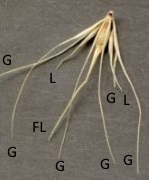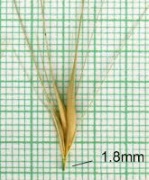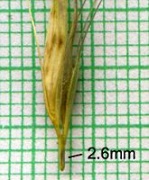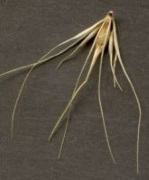Is it a native?
Barley Grasses - introduced (*Hordeum species)
Barley Grasses are a distinctive and common group of introduced grasses. The spikelets are in threes, so that each triplet has six glumes. The glumes may be narrow, or widened at the base. The lemmas taper into a long straight awn. The groups of spikelets are clustered into a spikey cluster.

Barley Grass triplet. G= glume, L= infertile lemma, FL = fertile lemma. Part of one of the outer glumes has a broken tip. Sea Barley Grass.
 Northern Barley-grass *Hordeum glaucum. Both glumes of the inner spikelet and the inner glume of the outer spikelets are widened at the base and hairy. The stem just below the join of the three spikelets is c2mm long. Leaves are usually bluish. The anthers of the central floret are dark.
Northern Barley-grass *Hordeum glaucum. Both glumes of the inner spikelet and the inner glume of the outer spikelets are widened at the base and hairy. The stem just below the join of the three spikelets is c2mm long. Leaves are usually bluish. The anthers of the central floret are dark.
Barley Grass *Hordeum leporinum. Both glumes of the inner spikelet and the inner glumes of the outer spikelets are widened at the base and hairy. The anthers of the central floret are pale. The stem just below the join of the three spikelets is 2.5mm long or more. Leaves usually green.

Sea Barley-grass *Hordeum marinum. The glumes of the central spikelet are narrow near the base, and taper to a point. The inner glumes of the outer spikelets are broadened at the base, the outer glumes are narrow. The glumes are rough to touch but not hairy. The lower leaf sheaths are hairless or with hairs <0.5mm. Salt-tolerant.

Mediterranean Barley Grass *Hordeum hystrix. The glumes of the central spikelet are narrow near the base, and taper to a point. Both glumes of the outer spikelets are narrow. The glumes are rough to touch but not hairy. The lower leaf sheaths are hairy with hairs >0.5mm.
Hordeum: old Latin name for barley.